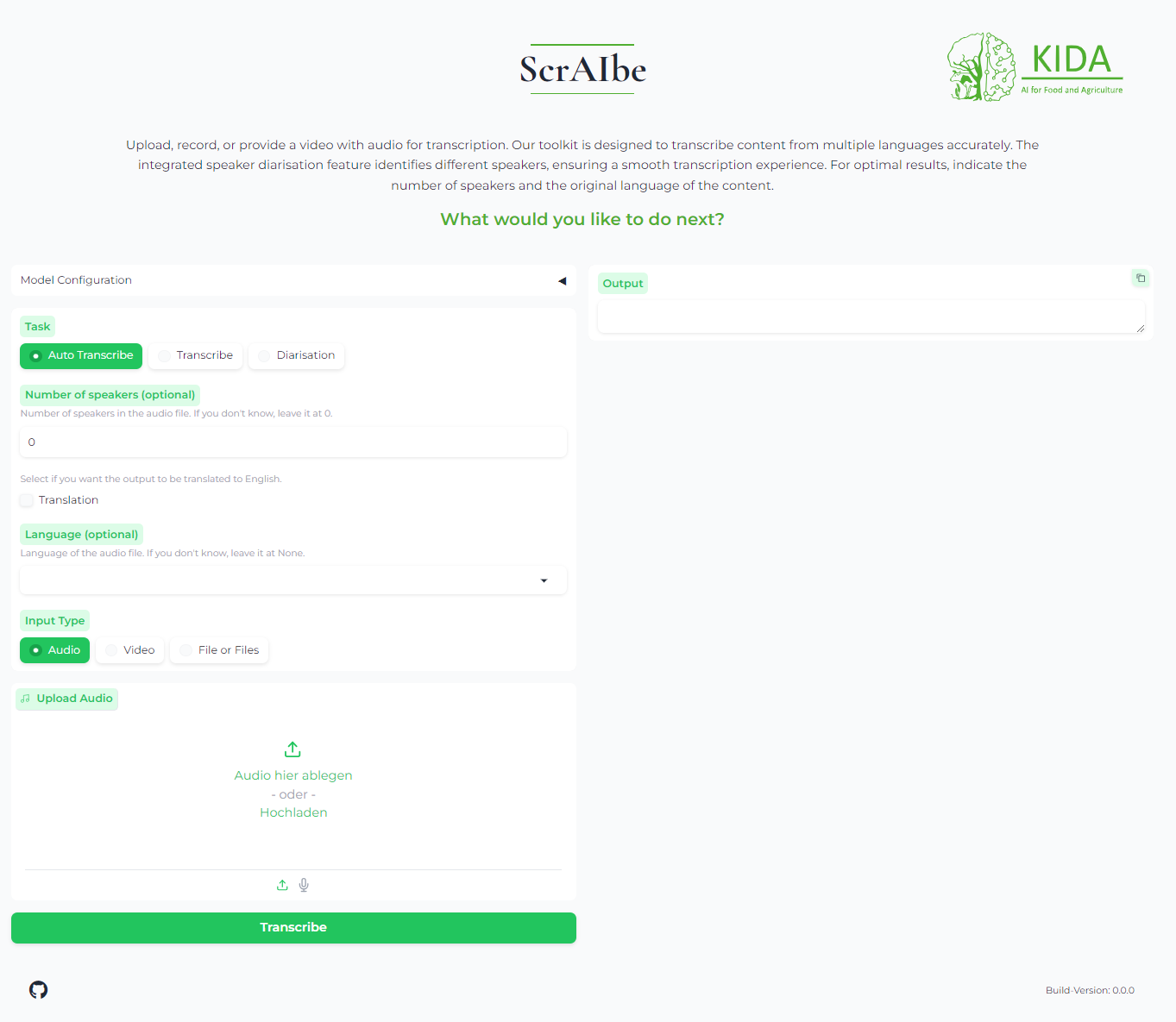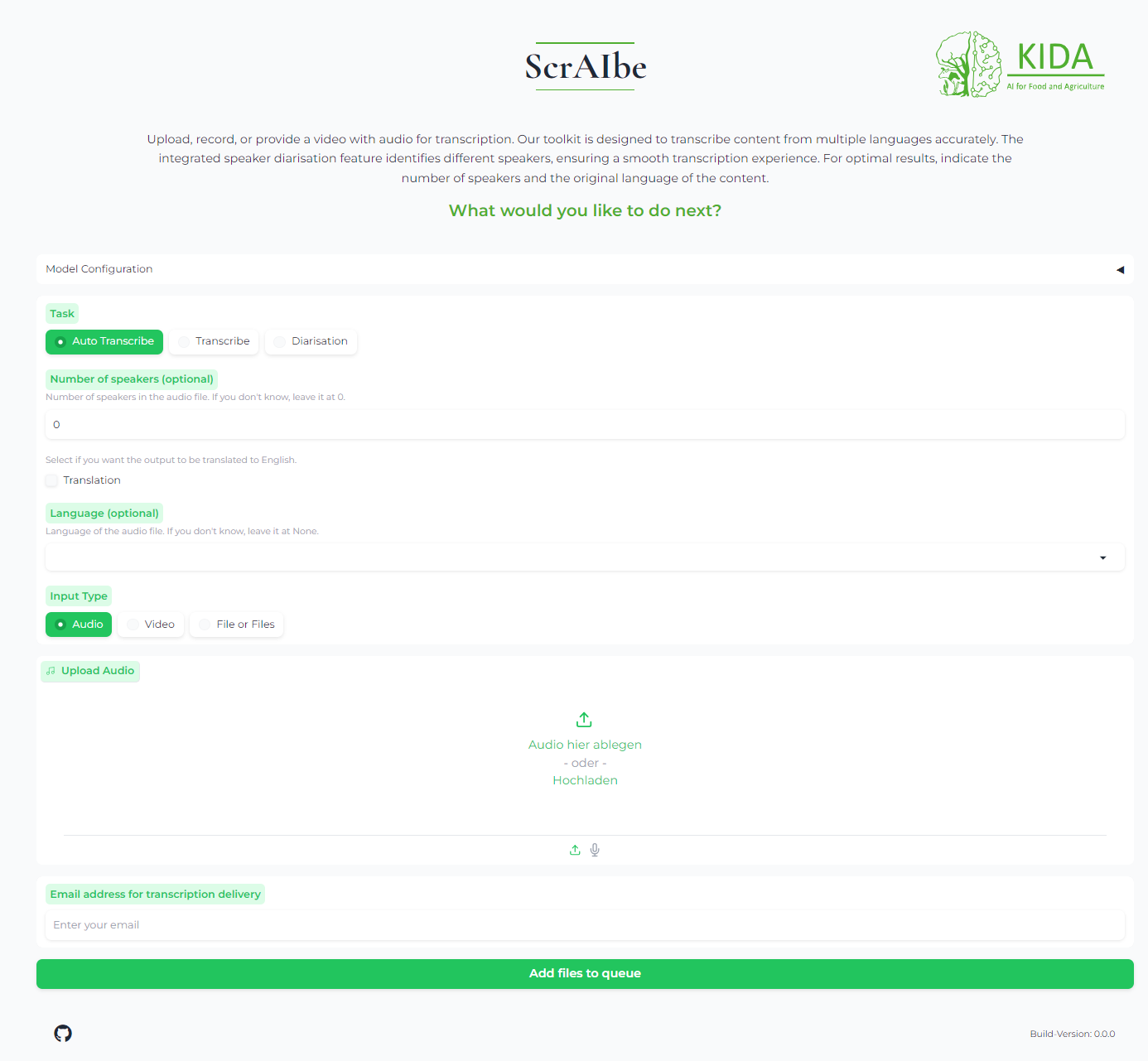Welcome to ScrAIbe-WebUI, a user-friendly web service for automated transcriptions, built on top of our innovative backend framework, ScrAIbe. ScrAIbe-WebUI provides a no-code solution that allows users to deploy the service locally with ease using Docker.
- User-Friendly Interface: Leveraging Gradio, ScrAIbe-WebUI provides an intuitive web interface that makes it easy for users to interact with the transcription services without any coding requirement.
- Synchronous Transcription 🕒: Perfect for live applications, this mode allows users to perform real-time transcriptions, enabling instant text output as audio is being spoken.
- Asynchronous Transcription 📨: ScrAIbe-WebUI is designed for asynchronous processing, allowing users to connect ScrAIbe-WebUI to a mail client, allowing them to upload their audio or video files using the WebUI, that are automatically transcribed, with results sent back via email including file attachment.
- Broad File Format Compatibility 🎥🎙: Supports a wide range of audio and video file types compatible with FFmpeg, ensuring flexibility in handling media from various sources. This means you can use almost any media file format, including MP3, WAV, MP4, AVI, MKV, and many more.
- Direct Input Options 📹: Users can directly utilize their webcam or microphone to record audio or video for transcription.
- Multiple Transcription Models 🌍: Users can select from all available Whisper models, accommodating multiple languages to suit global needs. Additionally, WhisperX is included, providing quantized models that deliver much faster performance on CPU, making transcription more efficient and accessible.
- Speaker Diarization 🗣: Integrates with Pyannote, an advanced tool for speaker diarization. This feature identifies and separates different speakers in the transcription process, ensuring accurate and clear attribution of speech to individual speakers.
- Custom Configuration ⚙️: Users can fine-tune settings and preferences via a
config.yamlfile. This file allows for detailed customization of the application's behavior, including specifying custom headers, footers, and other UI elements, as well as configuring transcription models and service parameters. - CLI Support 🖥: For advanced users, ScrAIbe-WebUI includes a powerful command line interface, enabling scripting and automation of transcription tasks. This makes it ideal for integrating with other tools and workflows in a seamless and efficient manner.
- Docker Compatibility 🐳: Enjoy easy and consistent deployment using Docker. With Docker, you can run ScrAIbe-WebUI in a containerized environment, ensuring that it runs smoothly across different systems and configurations.
- Docker Compose Support 📦: Manage multi-container Docker applications with ease using Docker Compose. This feature simplifies the process of setting up and managing complex applications by allowing you to define and run multi-container Docker applications in a single file.
- GPL-3.0 License 📜: ScrAIbe-WebUI is open source and licensed under the GPL-3.0 license, promoting collaboration and development within the community. We encourage contributions from developers and users to help improve and expand the capabilities of the application.
ScrAIbe-WebUI makes it easy to start transcribing with multiple installation methods tailored to suit your needs. Whether you’re a beginner or an advanced user, we have you covered!
- Docker 🐳: The simplest and most efficient way to deploy ScrAIbe-WebUI. Containerize the application to ensure a consistent environment across different systems. Get Started with Docker
- PyPI Package 📦: Install ScrAIbe-WebUI via pip for seamless integration with your Python environment. Learn How to Install via PyPI
- Build from Scratch 🔧: For those who like to get their hands dirty, build ScrAIbe-WebUI from the ground up. See the Step-by-Step Guide
For detailed step-by-step instructions on each installation method, please refer to our comprehensive Getting Started Guide. This guide will walk you through everything you need to know to set up and configure ScrAIbe-WebUI.
If you prefer the easiest and quickest setup, we highly recommend using Docker. This method allows you to containerize ScrAIbe-WebUI, ensuring a consistent and hassle-free deployment across various environments.
Ready to dive in? Check out our Docker Guide and get started in no time!
Happy transcribing! 🎉
For those looking to customize and extend the functionality of ScrAIbe-WebUI, our Advanced Setup Tutorial provides all the details you need. From fine-tuning configurations to integrating additional features, this guide will help you make the most of ScrAIbe-WebUI's powerful capabilities.
We warmly welcome contributions from the community! Whether you’re fixing bugs, adding new features, or improving documentation, your help is invaluable. Please see our Contributing Guidelines for more information on how to get involved and make your mark on ScrAIbe-WebUI.
ScrAIbe-WebUI is proudly open source and licensed under the GPL-3.0 license. This promotes a collaborative and transparent development process. For more details, see the LICENSE file in this repository.
Join us in making ScrAIbe-WebUI even better! 🚀

